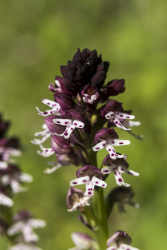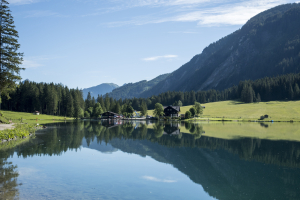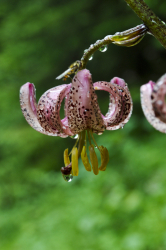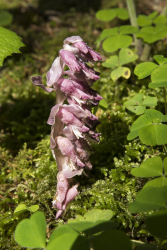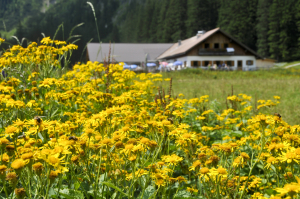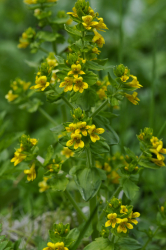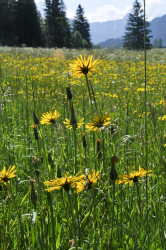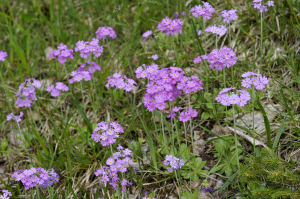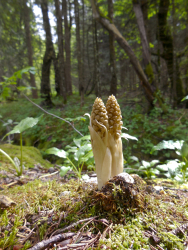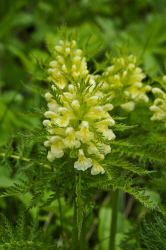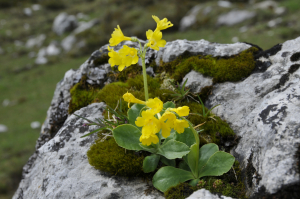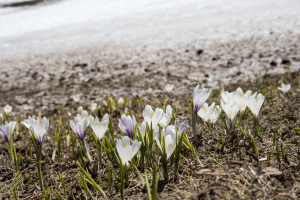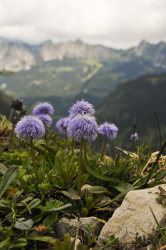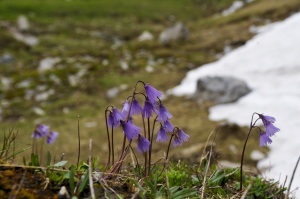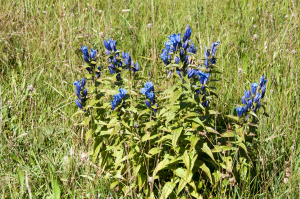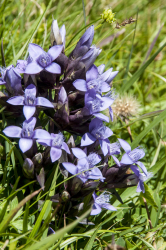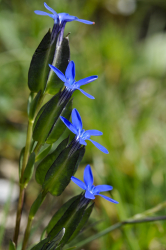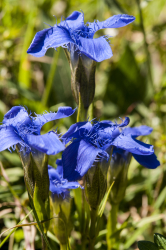Idyllic mountain lake
The mountain lake Vilsalpsee, near Tannheim, Austria, is an idyllic, perhaps magical, place. From Tannheim it is an hour’s walk, but you can also go there by car, bus, or the Tannheimer Alpenexpress, which is a tram pulled by a tractor. Surrounded by 6,500 foot (2,000 m) high mountains and flanked by alpine meadows, is the beautiful 1,700 acre (700 ha) natural mountain lake. The flower display starts in the so-called Buckelwiese (hummocky meadow) to the south of the village. In the spring, this meadow is full of various orchids, gentians, and Polygala and a few weeks later the striking burnt orchid, Neotinea ustulata, blooms there. Such meadows were created in the past by clearing the forest and throwing the tree stumps and stones into heaps. In the years that followed, the heaps smoothed out, gradually becoming nothing more than slight elevations in the terrain. This slightly undulating terrain does affect plant growth, with different species growing on top of the hills and others in the small valleys in between. When I first arrive, I always take a walk in this area and often lie flat on the ground to admire gentians, orchids, and primroses. Lilium martagon is in bloom in spring along the paths in the forest to the lake and a little deeper in the forest you can find, with a little luck, the rare parasitic Lathraea squamaria.
A walk along the lake is an experience. While you enjoy the beautiful views over the lake, pay particular attention to the steep slope on the right side of the path. On the slope there are gentians, violets, primroses, and bell flowers and sometimes you can see a Lilium martagon or an Epipactis atrorubens, a tall but usually inconspicuous orchid that grows in several places along the path. In the distance, surrounded by meadows, beckons the Vilsalpe, a mountain restaurant with a large terrace where you can stop for a rest.
After the Vilsalpe we enter the forest. Early in the year Hepatica blooms there, but in May you will only see the leaves. For most visitors, the main attraction is the waterfall at the end of the valley, but for plant people, the scree slopes and wet valleys just before the waterfall are the real attractions. Caltha palustris is still in bloom in May as are the beautiful flowers of Petasites albus between the boulders and rubble. Also noteworthy are the many specimens of Tozzia alpina, a yellow flowering plant that is now part of the Orobanchaceae. In its first year, it is a parasite on grass and after that it grows as a hemiparasite that has green leaves and can photosynthesize but also extracts food from its host plants.
The valley in the spring
At the end of May, the hay meadows around Tannheim are yellow in the morning with the morning stars, Tragopogon pratensis. Nowhere I did see them as exuberant as just north of the village. Buttercups and Anthriscus sylvestris produce flowering meadows as you rarely see them, and you can smell their sweet scent from a distance. Walk through the meadows towards Grän and you will find Geranium sylvaticum and cuckoo flower providing some red and pink. In somewhat wetter places Polygonum bistorta produces its pink flower spikes, while on drier slopes the orange flowers of Crepis aurea stand out. These meadow flowers change the landscape into a festive carpet of color.
For alpine plant enjoyment, you want to hike on to the border with Germany. The road goes up slowly from Tannheim as you leave the wide valley and arrive in an environment of meadows interspersed with forests, streams, and moors. At the former border post, you can take a beautiful walk along the tree-flanked brook Weissenbach. Well-known plants such as Solomon’s seal and lily-of-the-valley grow in the partial shade of the trees, but you’ll also find the smelly Aposeris foetida, mysterious Neottia nidus-avis and Actaea spicata. But what is really thrilling are the thousands of Primula farinosa in the meadows along the side of the road. Usually the best time to see them in such masses is late May or early June. Among these primulas are also Polygala and sometimes Gentiana verna. The icing on the cake is Orchis mascula. There is no shortage of orchids in this valley. In the same meadows, you can find Pedicularis foliosa, never as plentiful as the primula, but the plants are much larger and you can hardly miss them. Like many other Pedicularis varieties, it is a beautiful plant but unfortunately difficult to grow in cultivation as they are hemiparasites that are dependent on a host plant, at least in the initial period.
Alpine spring flora
From Tannheim and Grän you can take the cable car to an altitude of between 6,200 and 6,500 feet (1900 and 2000 m). More and more hotels and apartments have a guest card that allows you to use the cable car once a day. There is a good chance that there is still snow up there at the end of May and that some trails are not yet accessible but there are always places where the spring flowers are already in full bloom. Primula auricula is a common plant in this limestone area, and what could be better than a snowfield with Crocus albiflorus on the edge? To see hundreds of flowering crocuses in June is quite an experience! Six feet (2 m) from the snow they will have already finished flowering and you can see the new leaves appearing above the ground. A dozen feet (4 m) further and they have completely disappeared in the grass.
When the snow is almost gone at the end of May, you can take various hikes from the mountain station of the Neunerköpfle and as a plant lover, you will see many alpine highlights after just half an hour's walk. I am always impressed by the beautiful blue balls of Globularia nudicaulis and the white flowers of Androsace chamaejasme. In scree slopes, if you look closely amid the rubble, you’ll find alpine cherry, Pritzelago alpina, covered with white flowers.
As a plant lover, don’t just take a photo of a flower with your phone from a height of three feet (1 m). Get down on your knees and take a photo of Soldanella alpina at eye level or let yourself be overwhelmed by a field of Gentiana verna. Don't think that you need an expensive camera for that, because you can also take beautiful close-up photos with a phone with a good camera. There, up in the mountains, you walk with your head in the spring and you see at your feet the last convulsions of winter.
Late summer
If you really can't get to the Alps in the spring, then the late summer also offers plenty of opportunities to view exceptional plants. The little ones from the alpine plant world will be at rest or are only present as green, but several tall varieties will be in their showy phase. You need a bit of luck with Veratrum album because they sometimes bloom badly for a year. If they do well, you will see them everywhere because the cattle avoid these plants like the plague and you can see them from a great distance in the bare-grazed land. I also find Gentiana asclepiadea to be a plant with a lot of charisma. At the edge of the forest it often grows a bit too high and the flowering is not optimal, but in a meadow the blue flowers stand out all the more. In the vicinity of Schattwald, Austria, there are several wet meadows where this gentian occurs on the edge and where the relatively unknown Swertia perennis, or pool gentian, grows in wet areas. I have not often seen Swertia on all my alpine trips, but there were dozens of flowering plants there at the end of August. It is a plant of the gentian family, growing up to 30 inches (75 cm) high with small purple flowers. It is the only species of this genus in Europe; many more species occur in Asia.
The star gentian, Gentiana cruciata, also blooms in August in the meadows west of Tannheim and Gentiana pneumonanthe can be found in many places in the Tannheim Valley. Gentians contain bitter substances that livestock do not like and some species are also poisonous. The animals graze around them giving the plants a perfect stage. This applies to the yellow gentian that can be seen here and there in the valley in the spring, but also to the blue-flowering varieties in the late summer. There is a big difference between the hay meadows and the meadows where the cattle graze. The hay meadows bloom in May to June and after mowing they become dull grassy plains. The grass of the meadows where the cattle graze is often a bit shorter and there are more low-growing flower plants in the spring. In late summer, the grass is grazed short with the poisonous or bad-tasting plants blooming everywhere, protruding high above the grass surface. One small fall-flowering variety is the fringed gentian, Gentianopsis (formerly Gentiana) ciliata. This is a biennial plant with fringes on the edge of the four petals. This gentian does not occur in large numbers anywhere and it is always a wow moment when you encounter it in full bloom. According to the books, it occurs in hay meadows and on forest edges, but I usually find it in the short grass at the edges of paths. Also blue is the aconite, Aconitum napellus, a very poisonous plant that is also avoided by livestock. This aconite does not grow in the meadows, but rather in the bushes at the edge of the forest and along streams. Late summer is also the time for the weather thistle, Carlina acaulis. The flowers of this stemless thistle are open when the sun is shining and closed when it is raining or cloudy. There are two subspecies, the common form without a stem and the stemless thistle with a stem, Carlina acaulis subsp. caulescens. Who makes up such a name?
A day hiking through the northern Alps, although sometimes tiring, gives you a lot of energy from the beauty of the plants, be they the short, flower-covered beauties of spring or the taller blooms of fall.


